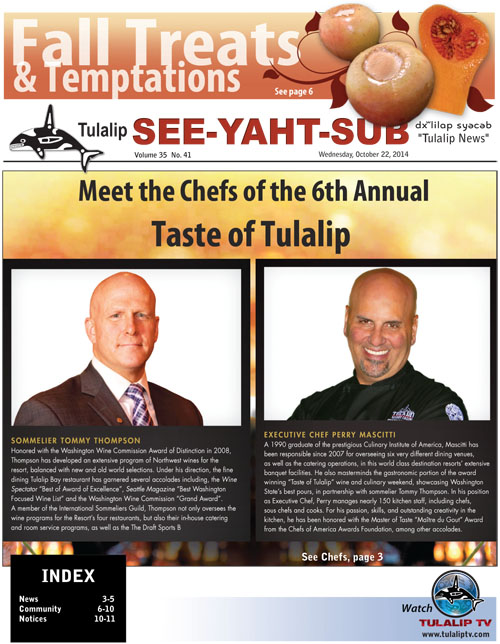Tulalip Diabetes Day is November 18 from 9am-3pm at the Karen I. Fryberg Tulalip Health Clinic
Lady Hawks show team spirit in spite of tough game against Highlanders, 0-3

By Brandi N. Montreuil, Tulalip News
TULALIP – Tulalip Heritage Lady Hawks hosted the Providence Classical Christian Highlanders on Monday, October 20, at the Francy J. Sheldon Gymnasium at Heritage High School.
The Lady Hawks were up for a tough battle when they walked on the court to play the Northwest 1B varsity volleyball league’s top contender, having only lost two games this season.
Despite the lacking score, the Lady Hawks performance during the game is a far cry from their last two seasons under coach Amy Andrews. New head coach Raveon Harrowa has used her strong background in volleyball to create a team spirit within the Lady Hawks ranks. This has resulted in consistent communication during rallies, something Coach Andrews struggled to develop in the team.
While the Lady Hawks continue to seek their win, the team’s growth cannot be denied as sportsmanship and team spirit bring their own winning qualities to the young team.
Heritage Hawks – 12 10 9 – 0
Providence Classical – 25 25 25 – 3
You can watch all Heritage Lady Hawks home games on channel 99 on Tulalip Broadband or online at www.tulaliptv.com.
Brandi N. Montreuil: 360-913-5402; bmontreuil@tulalipnews.com



Five Pacific Northwest Tribes Back Habitat Restoration Plan for Portland Harbor Superfund Site
After lingering for 14 years as the largest Superfund site in Oregon, and affecting the traditional gathering and ceremonial grounds of area tribes for decades, the first restoration project for the Portland Superfund Site has been greenlighted by five tribes on the Portland Harbor Natural Resource Trustee Council (Trustee Council).
“The Nez Perce Tribe (in Lapwai, Idaho), and the Confederated Tribes of Warm Springs, Umatilla, Siletz, and Grand Ronde (in Oregon) are on board,” Nez Perce spokesperson Erin Madden told Indian Country Today Media Network.
The Alder Creek restoration project is a 52-acre refuge for native fish and wildlife near the Willamette’s Sauvie Island, in Portland, Oregon. Wapato Island, as it is known locally, has been a traditional fishing, hunting and gathering area for tribes for more than 10,000 years.
But the once abundant habitat is now rare in this stretch of the river, Madden said. Decades of manufacturing waste fouled the final 12 miles of the Willamette River where it runs through the city of Portland until it streams into the Columbia River, 100 miles upstream from the Pacific Ocean. The Environmental Protection Agency (EPA) added the 12-mile site to the Superfund priority list in 2000.
Lurking in the river’s sediment is a nasty cocktail of high levels of the banned pesticide DDT, polycyclic aromatic hydrocarbons (PAHs), polychlorinated biphenyls (PCBs), heavy metals, tar deposits, solvents, petroleum byproducts, and phthalates known to interfere with the body’s hormones and cause developmental problems—left by decades of manufacturing processes, all of which pose risks to the water, natural resources, wildlife and humans.
The EPA and the tribes feeling the impact of the contamination entered into a memorandum of understanding to ensure that tribal government representatives have a seat at the table.
Related: Oregon Tribes Await Superfund Attention for Portland Harbor Site
The Yakama Nation in Washington State withdrew from the Trustee Council in 2009 over concerns that remediation of damages to natural resources would not extend to the injury and damages to natural resources in the lower Columbia River, and liability of the potentially responsible parties for damages, Yakama Nation public information officer Rose Longoria said.
Related: Yakama Nation Challenges Willamette River Polluters to Clean and Protect Lower Columbia River
The new project, designed to benefit fish and wildlife affected by contamination at the site, will include removing buildings and fill from the floodplain, reshaping the riverbanks, and planting native trees and shrubs. This project is the first of five remediation and restoration projects in various planning stages.
“It’s a pretty major milestone,” Madden said. “It’s the culmination of many years of work by the Nez Perce and the other tribes, and state and federal partners on the Trustee Council.”
Read more at http://indiancountrytodaymedianetwork.com/2014/10/14/five-pacific-northwest-tribes-back-habitat-restoration-plan-portland-harbor-superfund
Granite Falls, Tulalip seek EMS renewals
By Rikki King, The Herald
GRANITE FALLS — Fire districts in Granite Falls and Tulalip are asking voters to approve permanent emergency medical services levies to replace existing six-year levies.
The matters are on the November general election ballot.
Both levies would draw 50 cents per $1,000 of property value, or $100 for the owner of a $200,000 house.
“I just want to make sure that the voters understand that this is a renewal of the EMS levy at the same rate and not a new tax and not an increase in tax,” Granite Falls Fire Chief Jim Haverfield said.
His district is seeking the permanent levy in part to save on election costs for running a new levy every six years. That can cost up to $45,000 per election, he said.
Most fire districts in Snohomish County have permanent medical services levies, Haverfield said.
The EMS levy makes up about a quarter of the district’s annual revenues. At the same time, medical calls make up roughly 75 percent of their emergency calls.
“That is pretty significant,” Haverfield said. “Not having the EMS levy would have a dire consequence on our emergency service.”
If approved, the Granite Falls levy would generate an estimated $480,000 a year. The money would be used for staffing, supplies, rig maintenance and public outreach.
The Granite Falls district serves about 12,000 people over 38 square miles, including the city of Granite Falls.
A public meeting about the levy is planned for 7 p.m. Oct. 28 at the Granite Falls Fire Station, 116 S. Granite Ave.
October 22, 2014 Tulalip See-Yaht-Sub
Click the highlighted link below to download the October 22, 2014 Tulalip See-Yaht-Sub
Click here to download Oct 22 2014 SYS
Hibulb Cultural Center to hold annual Halloween party, Oct. 26
Tulalip Hibulb Cultural Center & Natural History Preserve will be hosting their annual Halloween Event on Sunday, October 26, from 1: 00 p.m. to 3:00 p.m.
Families are encouraged to dress in costume while attending the event, which will feature crafting projects, story time for youth and a movie.
For more information contact, Mary Jane Topash, Hibulb Group Tours Specialist at 360-716-2657.
Comcast and NBCUniversal Donate Over $5 Million in Advertising in Partnership with American Indian College Fund to Raise Awareness about Higher Education Needs in Native American Communities
SOURCE: American Indian College Fund
DENVER, Oct. 16, 2014 /PRNewswire-USNewswire/ — The American Indian College Fund (the College Fund), a national Native education non-profit, today announced that Comcast and NBCUniversal is partnering with them to further the cause of Native American higher education with a donation of $5 million of advertising for its 2015 public service announcement (PSA) on its cable system and an additional gift of $500,000 of in-kind services and cash. The support will help the College Fund launch its 25(th) anniversary goals to increase Native American scholarship support and financial assistance for the nation’s tribal colleges and universities to increase the number of Native Americans with a higher education.
Comcast and NBCUniversal’s commitment follows its 2013 donation of more than $6.35 million in television advertising time for the College Fund’s 30-second Help A Student Help A Tribe (www.tribalcollege.org) PSA. Comcast and NBCUniversal played the advertisement over several weeks in nine major metropolitan markets at prime viewing times, resulting in increased public awareness about the need to support Native higher education. Internationally renowned advertising agency Wieden+Kennedy and award-winning director Joe Pytka donated their talents to collaborate on the production of the PSA, which depicts the impact one person has on their Native American community after earning a higher education.
“We are delighted to support the American Indian College Fund’s mission to provide Native American students with access to affordable, high quality education, and congratulate them on 25 years of making a meaningful difference in the lives of Native American youth,” said Charisse R. Lillie, Vice President of Community Investment for Comcast Corporation and President of the Comcast Foundation. “As we prepare to celebrate Native American Heritage Month, we are proud to support the next generation of Native American leaders who strive to continue their education through tribal colleges and universities.”
Cheryl Crazy Bull, President and CEO of the American Indian College Fund said, “As indigenous people, we honor storytelling as a means of sharing our values and our way of life. The American Indian College Fund’s partnership with Comcast and NBCUniversal allows us to bring our story to a broader audience. The engagement of all Americans in the education of tribal people is strengthened when they hear our story. We appreciate that Comcast and NBCUniversal have allowed us to use their technology to share who we are with the rest of the country. They are part of the movement to improve American Indian higher education and we are proud of our partnership with them.”
About the American Indian College Fund
Founded in 1989, the American Indian College Fund has been the nation’s largest provider of support for Native higher education for 25 years. The College Fund provides an average of 6,000 scholarships annually and support for the nation’s 34 accredited tribal colleges and universities located on or near Indian reservations. The College Fund consistently receives top ratings from independent charity evaluators. For more information, please visit www.collegefund.org.
American Indian College Fund
Totem Middle School lock down lifted
By Brandi N. Montreuil, Tulalip News
MARYSVILLE – Totem Middle School was placed on lock down after police searching for a suspect on foot was last seen near the school area. The Marysville School District website stated the lock down was due to police activity near the area and not regarding any student activity on campus.
Students were not believed to be in any immediate danger and the lock down was a result of precautionary measures. Parents were not allowed to enter the school or pick up students during the lock down.
The Marysville Police lifted the lock down approximately at 2:08 p.m and school resumed normal operations.
The power of a pirouette
By Marshall Terrill, Special to GetOut of The East Valley Tribune

Photo courtesy of Sandy Osawa
Maria Tallchief was considered America’s first major prima ballerina and was the first Native American to hold such distinction.
Tallchief’s innovative role as the first sugar plum fairy in ‘Nutcracker’ and passionate dancing revolutionized the ballet but offstage her life was filled with personal struggles and discrimination.
ASU’s Simon Ortiz and Labriola Center Lecture on Indigenous Land, Culture, and Community presents Sandy Osawa’s ‘Maria Tallchief,’ a documentary that will be screened at 7 p.m. on Thursday, Oct. 16 at the Heard Museum, 2301 N. Central Ave., Phoenix.
Osawa will follow the free screening and lecture with a Q & A about her one-hour documentary, which aired on PBS from 2007-2010. Osawa broke media barriers in the 1970s by launching the first 10-part national television series to be entirely produced, acted and written by Native Americans. She was also the first Native American filmmaker to produce a documentary for network television, called ‘The Eighth Fire,’ first broadcast on NBC stations in 1992.
Osawa spoke to Get Out from her home in Seattle, Washington, to discuss her landmark documentary and the life of one of the most brilliant ballerinas of the 20th century.
Q: What drew you as a filmmaker to Maria Tallchief’s story?
SO: What drew me to her story was the fact that there’s a shocking lack of Native American stories and she had been on my mind for some time. I first heard about her when I was in college, so that had always stayed in the back of my mind. Then years later I met her grown daughter, Elise Maria Paschen, at a writer’s workshop in Oregon. I asked Elise if there had ever been any full-length documentaries on her mother. She said, ‘No, there isn’t.’ Elise then gave me her mother’s number and I called her up. When I asked Maria Tallchief about the possibility of doing a documentary she said, ‘Let’s do it.’
Q: There were some parallels with you and Maria Tallchief in that you are both Native American women who were underrepresented in your respective professions. Did that help you relate to her?
SO: I actually did feel that there were layers, a lot of levels that existed between us. One of them was the fact that Maria Tallchief said she was shy growing up … painfully shy. I also suffered with that aspect of being shy. I went to school in Port Angeles, Washington and although there was a tribe nearby, there really weren’t any Native Americans at my school. Every summer I would go back to the reservation and that was very much a coming home period and it felt positive. Going back to school was the reverse feeling. Maria said she had that same feeling when balancing the Indian and non-Indian world. Maria was also very quiet about her own accomplishments and was reticent to say anything about her amazing career, which meant I had to resort to some of her friends, associates and family to fill in those gaps. Many people who are raised in a traditional Native American setting are not fond of bragging.
Q: I was surprised to discover there were factions in ballet and Tallchief was an outsider in terms of where she fit in this world.
SO: When she started her career, the only star ballerinas that existed were Russian and English, no Americans. For example, she was asked to change her name to Maria Tallchieva to sound Russian. It’s kind of hard to fathom this now, but this was in the 1940s and 1950s. She was America’s first prima ballerina. It’s a huge milestone people and are always asking, ‘Why didn’t we know about her then?’ It’s all boils down to who writes our history and whose story gets told.
Q: In addition to having to overcome hurdles in the ballet world, Maria Tallchief had a lot of personal issues to face.
SO: I think with any artist there are always going to be obstacles in the way and she certainly faced her share of them. Even when she was born there was turmoil. In the film we focus on a time period when she was young where her relatives were being murdered for oil. Being born a girl in that era and in that environment of murder, it did not look like a very good start for Maria. We show that in the beginning to demonstrate the stress that exists in most Native Americans lives. There are difficulties, there’s hardships, and if you happen to be born into oil money, like her family was, there were tremendous obstacles.
Q: Maria Tallchief died in 2013 but was alive when your film first premiered in 2007. What was her reaction to the documentary?
SO: We set up the premiere at the Gene Siskel Film Center in Chicago so that we could be with her in the audience. She was actually living in a nursing home when we screened the film but was able to come that night and she sat in the front row right next to me. When it ended, she got up and publicly thanked us and was very happy with the film. Her daughter later confirmed how appreciative Maria was. It was very nerve wracking for me because when you’re dealing with a legend, you’re very nervous if you’ve nailed it or not. It was a great final affirmation that she was happy and that we had done a great job.
If you go
What: ‘Maria Tallchief’ lecture, film and Q & A
When: 7 p.m. Thursday, Oct. 16
Where: Heard Museum, 2301 N. Central Ave., Phoenix.
Cost: Free
Information: (602) 252-8840 or Heard.org/events
Native Firm Wins Prestigious Health Communications Award
By KAI Meida Release
 Kauffman & Associates, Inc., an American Indian-owned communications and professional services firm, has won the 2014 National Health Information Award for its 2-year national campaign encouraging American Indians and Alaska Natives to sign up for health insurance under the Affordable Care Act. Other 2014 award winners include the American Association of Retired Persons, American Lung Association, Parents Magazine and the Mayo Clinic. The National Health Information Awards program honors high-quality consumer health information. The awards program is organized by the Health Information Resource Center, a national clearinghouse for consumer health professionals who work in consumer health education fields.
Kauffman & Associates, Inc., an American Indian-owned communications and professional services firm, has won the 2014 National Health Information Award for its 2-year national campaign encouraging American Indians and Alaska Natives to sign up for health insurance under the Affordable Care Act. Other 2014 award winners include the American Association of Retired Persons, American Lung Association, Parents Magazine and the Mayo Clinic. The National Health Information Awards program honors high-quality consumer health information. The awards program is organized by the Health Information Resource Center, a national clearinghouse for consumer health professionals who work in consumer health education fields.
Working with its client, the Centers for Medicare and Medicaid Services’ (CMS) Tribal Affairs Group, KAI tested messages and images with American Indian and Alaska Native stakeholders throughout the United States and created radio spots, videos, billboards, bus signs, brochures, fact sheets and social media spots. KAI also recruited partner organizations from across the country and conducted outreach at large powwows, conferences, summits and sports events. KAI Vice President for Communications, Kim Blessing, reported “the campaign generated more than 100 million media impressions, recruited 113 tribal and organizational partners and distributed 23,000 informational brochures”.
“American Indian and Alaska Native people finally have the opportunity to ensure their health needs are fully covered, but they have to sign up. This is so important. It was a privilege to help CMS with this campaign,” said KAI President Jo Ann Kauffman, a public health professional and member of the Nez Perce Tribe.
The campaign also included a 7-minute video featuring former CBS News reporter Hattie Kauffman. This video, directed by Josephine Keefe, won the 2014 Telly Award earlier this year. The video is available online and is currently being played in Indian health clinic waiting rooms across the nation. Monthly radio public service announcements (PSA) were also produced by KAI, and featured both English and Native language speakers. Radio PSAs were sent to Native radios each month on topics about special benefits and protections for American Indians and Alaska Natives. These PSAs were recorded in English, Navajo, Lakota, Ojibwe and Yupik. Companion “drop-in” articles were placed in Native newspapers to reinforce the radio messages.
KAI has provided research and communications support to federal agencies, tribes, nonprofits and foundations in the area of public health, education, justice and community development since 1990.











